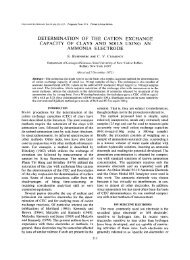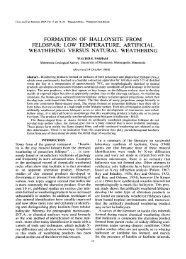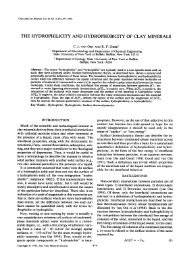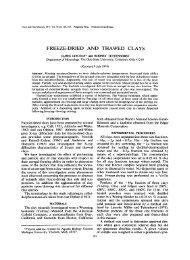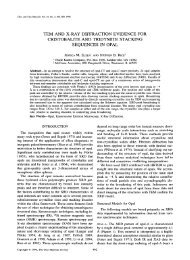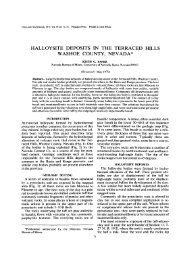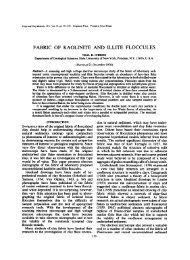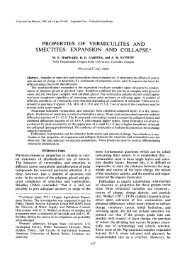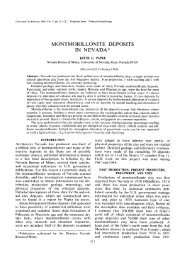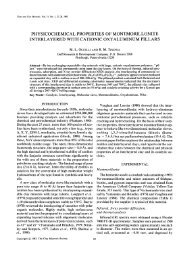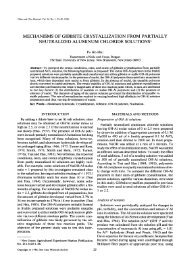mineralogical and geochemical study of clay mineral ...
mineralogical and geochemical study of clay mineral ...
mineralogical and geochemical study of clay mineral ...
Create successful ePaper yourself
Turn your PDF publications into a flip-book with our unique Google optimized e-Paper software.
Clays <strong>and</strong> Clay Minerals, 1968, Vol. 16, pp. 365-372. Pergamon Press. Printed in Great Britain<br />
MINERALOGICAL AND GEOCHEMICAL STUDY<br />
OF CLAY MINERAL TRANSFORMATIONS IN<br />
THE SEDIMENTARY TRIASSIC JURA BASIN<br />
(FRANCE)<br />
JACQUES LUCAS <strong>and</strong> G{)ROL ATAMAN*<br />
Centre de S6dimentologie et de G6ochimie de la Surface, Strasbourg, France<br />
(Received 1 December 1967)<br />
Abstract- A detailed <strong>study</strong> <strong>of</strong> sediments from the Triassic <strong>of</strong> the French Jura shows that <strong>clay</strong> <strong>mineral</strong>s<br />
vary continuously with the facies. Near the coasts <strong>of</strong> the Jura Sea, sediments consisted <strong>of</strong> s<strong>and</strong>y,<br />
continental detritus <strong>and</strong> the <strong>mineral</strong>s are poorly crystallized. At the center <strong>of</strong> the basin, in what was<br />
a cation-rich chemical environment, they are well crystallized. A progressive <strong><strong>mineral</strong>ogical</strong> variation<br />
can be observed from degraded illite to well-crystallized chlorites passing through the intermediate<br />
stages <strong>of</strong> more-or-less regular mixed-layer structures. This variation is due to a true crystalline<br />
transformation.<br />
Similarly, chemical variations in <strong>clay</strong> <strong>mineral</strong>s <strong>and</strong> whole-rock samples are related to the paleo-<br />
geography <strong>of</strong> the basin. The distribution <strong>of</strong> major <strong>and</strong> trace elements is a function <strong>of</strong> distance from<br />
the Jura Sea coastline <strong>and</strong> also a function <strong>of</strong> the <strong><strong>mineral</strong>ogical</strong> composition <strong>of</strong> the fine fraction. The<br />
most obvious relationships are: (1) An increase in the concentration <strong>of</strong> MgO <strong>and</strong> the percentage <strong>of</strong><br />
ignition-loss water from the coast toward the deep sea; (2) A decrease in the concentration <strong>of</strong> SiO2,<br />
A1203, <strong>and</strong> TiO2 as well as that <strong>of</strong> trace elements such as vanadium, gallium, <strong>and</strong> cobalt from the<br />
coastal regions to the center <strong>of</strong> the basin; (3) A lack <strong>of</strong> statistically significant variations in the<br />
concentration <strong>of</strong> Fe203, Mn304, B, <strong>and</strong> Ni throughout the basin.<br />
The authors conclude that: ( 1 ) Transformations (aggradations) observed by means <strong>of</strong> X-ray diffrac-<br />
tion methods are in agreement with the chemical analyses; (2) Transformations are contemporaneous<br />
with the sedimentation; they are not diagenetic; (3) Clay <strong>mineral</strong>s play an important role in the<br />
<strong>geochemical</strong> balance <strong>of</strong> sedimentary basins.<br />
INTRODUCTION<br />
AT THE 10th National Conference on Clays <strong>and</strong><br />
Clay Minerals in 1961 G. Millot presented pre-<br />
liminary results on transformations <strong>of</strong> <strong>clay</strong> <strong>mineral</strong>s<br />
in the Triassic sediments <strong>of</strong> the Jura Basin (Millot,<br />
Lucas, <strong>and</strong> Wey, 1963). Since then, two studies<br />
on this basin have been completed, one on the<br />
<strong>mineral</strong>ogy (Lucas, 1962) <strong>and</strong> the other on the<br />
geochemistry <strong>of</strong> these sediments (Ataman, 1967).<br />
This paper synthesizes these investigations.<br />
SUMMARY OF THE PALEOGEOGRAPHICAL<br />
EVOLUTION OF THE TRIASSIC JURA BASIN<br />
The sedimentary evolution <strong>of</strong> the basin was<br />
reconstructed from analyses <strong>of</strong> samples from<br />
eight drill holes. Three <strong>of</strong> the drill holes are<br />
located on the eastern side <strong>of</strong> the Jura chain;<br />
Fraignot 1 <strong>and</strong> 2 (F1 <strong>and</strong> F0 <strong>and</strong> Montcoyj (My).<br />
The other five, Montboutont (Mb), Lons:~ (L),<br />
Toillonl (T), Valempouli~res (V) <strong>and</strong> Laveron<br />
*Present address: Hacettepe Universitesi, Kimya<br />
BSliimii, Ankara, Turkey.<br />
365<br />
(La) are in the Jura proper. The thickness <strong>of</strong><br />
total Triassic sediment increases from Fraignot,<br />
where it is 100 m, to Laveron, where it exceeds<br />
1400 m.? The drill holes nearest the Massif Central<br />
are the most detrital <strong>and</strong> s<strong>and</strong>y. Toward the center<br />
<strong>of</strong> the Basin <strong>clay</strong>, carbonate <strong>and</strong> evaporite facies<br />
increase in abundance <strong>and</strong> become predominant<br />
at the Laveron drill hole where salt formations are<br />
about 600 m thick.<br />
The topography <strong>of</strong> the Jura region during the<br />
Triassic must be reviewed in order to underst<strong>and</strong><br />
the sedimentological history <strong>of</strong> the basin. More<br />
detailed paleogeographic reconstructions may be<br />
found in Ricour (1962) <strong>and</strong> Lucas (1962). Jura<br />
Basin sedimentation occurred sufficiently after the<br />
Hercynian Orogeny that continental relief was<br />
minimal. The Triassic sea encroached upon a<br />
continental shelf bounded by relatively smooth<br />
<strong>and</strong> gently rolling coasts. The Jura region was<br />
?A figure <strong>of</strong> the basin with the location <strong>of</strong> the drill<br />
holes is given in Lucas (1962), Millot, Lucas, <strong>and</strong> Wey<br />
(1963), Ataman (1967).
366 J. LUCAS <strong>and</strong> G. ATAMAN<br />
covered by a shallow epicontinental sea bounded<br />
on the western side by the Massif Central <strong>and</strong> on<br />
the east by the edge <strong>of</strong> the continental slope. This<br />
epicontinental sea faced the deep Mesogean sea,<br />
the location <strong>of</strong> the present Alps. The Jura Basin<br />
was separated from the Alpine Sea by a shallow<br />
sill or bar at the edge <strong>of</strong> the Continental Shelf<br />
(Fig. 1).<br />
supplied with detrital sediments from the Massif<br />
Central to the west <strong>and</strong> with evaporite deposits<br />
caused by supersaturation <strong>of</strong> evaporating sea<br />
water.<br />
STUDY OF CLAY MINERALS (LUCAS, 1962)<br />
In the s<strong>and</strong>stone facies, adjacent to the Triassic<br />
coast line, the <strong>clay</strong> <strong>mineral</strong>s are principally<br />
Massif Subsident basin Bar Alpine<br />
central <strong>of</strong> juro sea<br />
Principally, carbonate sediments <strong>of</strong> the Alpine<br />
facies were deposited in the deep sea while on the<br />
continental shelf, sedimentary deposits <strong>of</strong> the<br />
Germanic facies accumulated. The thickness <strong>of</strong><br />
the formations shown by the drill holes demon-<br />
strates that an important subsidance in the vicin-<br />
ity <strong>of</strong> Laveron affected the Continental Shelf, but<br />
it is likely that sedimentation took place constantly<br />
under only shallow water conditions.<br />
In this topographic context, it is certain that<br />
the only detrital continental source <strong>of</strong> sediment was<br />
the Massif Central on the western flank <strong>of</strong> the<br />
basin. On the other side <strong>of</strong> the basin, the epi-<br />
continental sea communicated freely with deep<br />
sea. It is possible that in some places a submarine<br />
shelf separated the two environments, but it is<br />
more probable that the edge <strong>of</strong> the continental<br />
plateau itself, where the bar acted as a sill,<br />
constituted a sufficient barrier.<br />
Under the warm, although certainly not arid,<br />
Triassic climate, evaporation was intensive <strong>and</strong><br />
the water supplied to the continent was insuffici-<br />
cient to replenish the amount lost by evaporation;<br />
thus a permanent current was created from the<br />
open sea toward the sea <strong>of</strong> the continental plateau.<br />
This process <strong>of</strong> increasing salinity is similar to<br />
that described by Ochsenius (1877) <strong>and</strong> by Sloss<br />
(1953). On the western side <strong>of</strong> the basin, the<br />
salt water was diluted by fresh waters draining<br />
from the continent which precluded precipitation<br />
<strong>of</strong> salt deposits.<br />
In summary, Jura Basin sediments were de-<br />
posited on a subsiding continental shelf <strong>and</strong> were<br />
Fig. 1. Section across reconstructed Triassic Jura Basin.<br />
J<br />
degraded illite which, in X-ray diffractograms,<br />
show a 10A reflection, broad <strong>and</strong> open toward<br />
small angles. This illite is accompanied by small<br />
percentages <strong>of</strong> kaolinite <strong>and</strong> chlorite, also poorly<br />
crystallized. Electron micrographs <strong>of</strong> these <strong>clay</strong>s<br />
reveal very small particles without apparent crystal-<br />
line shapes <strong>and</strong> concentrated in rounded aggre-<br />
gates. We conclude that these <strong>mineral</strong>s represent<br />
the detrital contribution originating in the exposed<br />
rocks <strong>of</strong> the Massif Central.<br />
Going basinward from the coast, the facies<br />
become less s<strong>and</strong>y <strong>and</strong> the composition <strong>of</strong> <strong>clay</strong><br />
<strong>mineral</strong>s progressively changes. Mixed-layer<br />
<strong>mineral</strong>s occur, as evidenced by broadening <strong>of</strong> the<br />
illite reflection toward small angles. Progressing<br />
basinward, a diffuse reflection appears between<br />
10 <strong>and</strong> 14A, <strong>and</strong> then the reflection tends to<br />
become distinct nearer 14 _A <strong>and</strong> forms a mixed-<br />
layer <strong>mineral</strong> <strong>of</strong> the (14c-14~) type.<br />
Still farther from the coast, this mixed-layer<br />
<strong>mineral</strong> becomes more regular, resulting in an<br />
excellent corrensite. But the evolution is not<br />
finished because corrensite gives way to a new<br />
mixed-layer <strong>mineral</strong>, more like chlorite, <strong>and</strong> <strong>of</strong> a<br />
(14c-14~;) type. Then, in the drill hole at Laveron,<br />
in the thickest part <strong>of</strong> the sedimentary basin, the<br />
mixed-layer <strong>mineral</strong>s give way to a well-crystal-<br />
lized chlorite which has strong, sharp reflections.<br />
Paralleling this progression <strong>of</strong> the 14 A population,<br />
X-ray reflections <strong>of</strong> illite also become sharper <strong>and</strong><br />
approximate those <strong>of</strong> a well-crystallized mica.<br />
This evolution may be summarized as follows:<br />
Degraded illite <strong>and</strong> chlorite ~ irregular (14c- 14M)
mixed layers --~ corrensite ~ irregular (14c-14c)<br />
mixed layers --~ well crystallized chlorite.<br />
The <strong><strong>mineral</strong>ogical</strong> evolution is also well defined<br />
by electron microscopy because, in the central<br />
parts <strong>of</strong> the basin, the predominant chlorite <strong>and</strong><br />
illite constituents reveal well-formed hexagonal<br />
crystals exceeding 1/x in length. This evolution<br />
which takes place from the coast toward the<br />
center <strong>of</strong> the basin is also more-or-less completely<br />
observed from the bottom to the top <strong>of</strong> the drill<br />
holes, the oldest or deepest sediments being less<br />
well crystallized than the youngest or topmost<br />
sediment. A similar relation between the nature<br />
<strong>of</strong> <strong>clay</strong>s <strong>and</strong> the petrology <strong>of</strong> sediment has been<br />
pointed out by Millot, Lucas, <strong>and</strong> Wey (1963).<br />
This variation <strong>of</strong> <strong>clay</strong> <strong>mineral</strong>s across the basin<br />
is explained by a process <strong>of</strong> continual trans-<br />
formation. If, in the center <strong>of</strong> the basin, chlorite<br />
<strong>and</strong> illite appear in well-formed, large crystals,<br />
they could not have originated directly as detritus<br />
from the continent. Near the Massif Central, the<br />
only detrital source for the basin, <strong>clay</strong> <strong>mineral</strong>s<br />
are very small <strong>and</strong> poorly crystallized. As the<br />
particles progress into the basin, they enter an<br />
environment increasingly rich in dissolved cations.<br />
The least-degraded illites pick up potassium, im-<br />
proving their crystallinity. The illites which are<br />
too degraded to be thus reconstituted, take up<br />
magnesium, becoming mixed-layer <strong>mineral</strong>s <strong>and</strong>,<br />
ultimately, well-crystallized chlorite. This is not<br />
a true ne<strong>of</strong>ormation [or authigenic formation]<br />
from a solution, but a transformation from a<br />
degraded <strong>mineral</strong> into a different, well crystal-<br />
lized one, the mixed layering constituting inter-<br />
mediate stages in the process. This inverse process<br />
<strong>of</strong> degradation is called "aggradation" (Lucas,<br />
1962).<br />
CHEMICAL STUDY OF SEDIMENTARY ROCKS<br />
(ATAMAN, 1967)<br />
More than one thous<strong>and</strong> complete major <strong>and</strong><br />
minor element analyses by direct reading emission<br />
spectrometry have been made upon the total<br />
rock samples <strong>and</strong> upon the extracted <strong>clay</strong> fraction<br />
(Ataman, 1963; Ataman <strong>and</strong> Besnus, 1965). We<br />
shall not detail here the distribution <strong>of</strong> these<br />
elements in the basin as this has been summarized<br />
in Ataman <strong>and</strong> Lucas (1967). Rather we shall<br />
discuss the evolution <strong>of</strong> some typical elements by<br />
considering variations in the average concentra-<br />
tions <strong>of</strong> the elements or their chemical compounds.<br />
Figure 2 shows the variations between drill<br />
holes in the average concentrations <strong>of</strong> MgO,<br />
A1203, <strong>and</strong> SiO2. It is obvious that the silica con-<br />
tent <strong>of</strong> the total rock decreases considerably from<br />
the coast to the open sea. This is easily explain-<br />
able since the concentration <strong>of</strong> detrital <strong>mineral</strong>s,<br />
CLAY MINERAL TRANSFORMATIONS 367<br />
especially quartz, the most silicious component,<br />
decreases in the same direction. But silica, which<br />
is a constituent <strong>of</strong> <strong>clay</strong> <strong>mineral</strong>s, also decreases<br />
in a regular, progressive manner.<br />
The variations <strong>of</strong> A1203 in the total rock <strong>and</strong> in<br />
<strong>clay</strong>s, are very similar. This proves that alumina<br />
is principally contained in the <strong>clay</strong> <strong>mineral</strong>s <strong>and</strong><br />
that the <strong>clay</strong>s are less aluminous toward the open<br />
sea than near the coasts.<br />
Contrary to the trend <strong>of</strong> silica <strong>and</strong> alumina, MgO<br />
increases strongly in the <strong>clay</strong> fraction from the<br />
coast toward the open sea, but remains almost<br />
constant in the whole rock. Now in the most sea-<br />
ward drill holes, carbonate <strong>and</strong> salt facies are more<br />
abundant, <strong>and</strong> the absolute amount <strong>of</strong> <strong>clay</strong> de-<br />
creases. However, because the <strong>clay</strong> <strong>mineral</strong>s are<br />
more <strong>and</strong> more magnesian, despite their decreasing<br />
abundance, the MgO content <strong>of</strong> the whole rock<br />
remains almost constant.<br />
A comparison <strong>of</strong> the chemical composition <strong>of</strong><br />
the <strong>clay</strong> fraction in different facies is given in Fig. 3.<br />
Note that silica <strong>and</strong> alumina decrease between<br />
detrital <strong>and</strong> chemical facies, whereas magnesia<br />
increases strongly. These chemical variations in<br />
the <strong>clay</strong>s across the basin agree perfectly with the<br />
<strong><strong>mineral</strong>ogical</strong> variations described above.<br />
Moreover, variations in trace element concen-<br />
trations also reflect the same evolution. Thus,<br />
vanadium, gallium, <strong>and</strong> cobalt decrease from the<br />
coast toward the open sea, while chromium, zinc,<br />
copper, <strong>and</strong> lead increase. Nickel <strong>and</strong> boron remain<br />
approximately constant across the basin. We<br />
shall not attempt here an explanation <strong>of</strong> all these<br />
variations but will limit the discussion to boron.<br />
Minor element variations have been statistically<br />
correlated with major element variations elsewhere<br />
(Ataman, 1967).<br />
The boron content <strong>of</strong> the <strong>clay</strong>s as opposed to<br />
whole rock remains approx. 300 ppm across the<br />
basin despite an inferred, regular increase in<br />
salinity from the coast to the open sea. Boron has<br />
<strong>of</strong>ten been described as an indicator <strong>of</strong> salinity<br />
(Goldschmidt <strong>and</strong> Peters, 1932; L<strong>and</strong>ergren,<br />
1945, 1958, 1959; Degens et al., 1957; Tourtelot<br />
et al., 1961; Walker, 1963; Harder, 1964). There<br />
is thus in the sediments <strong>of</strong> the Jura Basin an<br />
anomaly which requires explanation.<br />
Calculations <strong>of</strong> statistical correlations between<br />
different major <strong>and</strong> minor elements (Ataman,<br />
1967) show a positive dependence between alumi-<br />
num <strong>and</strong> boron. Because, as we have noted, the<br />
aluminum content decreases regularly toward the<br />
center <strong>of</strong> the basin, the boron content should also<br />
decrease, but this is not the case. Under the<br />
influence <strong>of</strong> increasing salinity, however, the ratio<br />
<strong>of</strong> boron to aluminum does increase, so it is<br />
because aluminum decreases that boron remains
368 J. LUCAS <strong>and</strong> G. ATAMAN<br />
131<br />
12.<br />
II.<br />
I0.<br />
9.<br />
8.<br />
7.<br />
6.<br />
5.<br />
4.<br />
%<br />
20<br />
15<br />
iol<br />
5 .<br />
ol<br />
F I F z My L T V Lo<br />
F i F z My L T V Lo<br />
AI20 ~<br />
Fig. 2. Variations in the chemical composition <strong>of</strong> the <strong>clay</strong> fraction (<br />
constant. Hence, the concentration <strong>of</strong> boron does<br />
reflect an increase in salinity, but its correlation<br />
with aluminum disturbs the phenomenon. One<br />
may thus use the boron content <strong>of</strong> <strong>clay</strong>s as an<br />
indicator <strong>of</strong> salinity provided that the <strong>mineral</strong>-<br />
ogical composition <strong>of</strong> samples to be compared<br />
remains constant.<br />
The chemical results confirm the phenomenon<br />
<strong>of</strong> <strong>clay</strong> <strong>mineral</strong> transformations in the Triassic<br />
Jura Basin <strong>and</strong> permit its more precise definition.<br />
The detritus supplied to the basin consists princi-<br />
%<br />
50.<br />
40.<br />
35.<br />
30.<br />
25.<br />
20.<br />
15.<br />
10.<br />
l F z My L T<br />
i El<br />
1/\N<br />
/I !<br />
V l_a<br />
"\\\\<br />
) <strong>and</strong> <strong>of</strong> the whole rock ( ..... ).<br />
pally <strong>of</strong> degraded 2:1 micaceous <strong>clay</strong> particles,<br />
Tet-Oct-Tet, i.e. degraded illite. Interlayer<br />
positions <strong>of</strong> these particles are largely stripped <strong>of</strong><br />
cations by continental weathering, leading also<br />
to a degradation <strong>of</strong> the silicate layer itself. Upon<br />
arrival in an environment <strong>of</strong> increased dissolved<br />
cation concentration, these interlayer positions<br />
tend to refill, especially with magnesium ions for<br />
which <strong>clay</strong> <strong>mineral</strong>s seem to have the strongest<br />
affinity. Thus, as magnesium is fixed, degraded<br />
lattices are progressively rebuilt to form mixed
I 2 3<br />
~~ ,<br />
iO.<br />
4 5<br />
CLAY MINERAL TRANSFORMATIONS 369<br />
I S<strong>and</strong>s<br />
2 CLays<br />
$ Limestones<br />
4 Dolomites<br />
5 Salt<br />
6 Sulfate<br />
Fig. 3. Variations in the chemical composition <strong>of</strong> the<br />
<strong>clay</strong> fraction <strong>of</strong> different sedimentary facies.<br />
layers, first irregular, then regular (corrensite),<br />
<strong>and</strong> result finally in a well-crystallized chlorite.<br />
This transformation is accompanied by an increase<br />
in crystallite size.<br />
The increase in the amount <strong>of</strong> magnesium con-<br />
tained in the <strong>clay</strong>s is accompanied by a decrease<br />
C.C.M. Vol. 16No. 5-D<br />
in aluminum <strong>and</strong> silicon. It is not, however,<br />
because <strong>of</strong> an increase in dissolved magnesium<br />
that this transformation occurs, since whole rock<br />
analyses show that magnesium remains constant<br />
across the basin, but is rather a function <strong>of</strong> supply<br />
<strong>and</strong> dem<strong>and</strong>. Near the coast, degraded particles<br />
are numerous <strong>and</strong> the concentration <strong>of</strong> available,<br />
dissolved magnesium is too low to fill all the poten-<br />
tial magnesium sites. Farther from the coast,<br />
the number <strong>of</strong> particles decreases <strong>and</strong> each <strong>of</strong> them<br />
has available more magnesium. But <strong>clay</strong> <strong>mineral</strong>s<br />
are not the only sites possible for magnesium; it<br />
is incorporated into carbonates also. This explains<br />
why in carbonate facies, especially dolomitic<br />
facies, <strong>clay</strong> <strong>mineral</strong>s are transformed only slightly.<br />
On the other h<strong>and</strong>, in saline environments where<br />
cation concentrations are not sufficient for highly-<br />
soluble magnesium chloride or sulfate to form,<br />
magnesium remains entirely available for <strong>clay</strong>s<br />
which can thus undergo extreme changes. But even<br />
in these super-saline environments, the competition<br />
for magnesium, though not vigorous, is none the<br />
less important. In the drill hole at Laveron, alter-<br />
nate layers <strong>of</strong> massive salt <strong>and</strong> <strong>clay</strong> correspond<br />
to alternate populations <strong>of</strong> either corrensite or<br />
chlorite respectively (Lucas, 1962; Millot, Lucas,<br />
<strong>and</strong> Wey, 1963). When salts precipitate, they<br />
remove magnesium <strong>and</strong> <strong>clay</strong> <strong>mineral</strong>s do not alter<br />
beyond the corrensite stage. When <strong>clay</strong>s are the<br />
principal materials deposited, all the magnesium<br />
is available to them <strong>and</strong> the <strong>clay</strong> <strong>mineral</strong>s reach<br />
the final aggradation stage <strong>of</strong> chlorite.<br />
DISCUSSION OF MINERAL TRANSFORMATIONS<br />
Transformation or ne<strong>of</strong>ormation<br />
One may possibly conceive <strong>of</strong> the <strong>mineral</strong>s<br />
found in the Triassic <strong>clay</strong>s as resulting from<br />
ne<strong>of</strong>ormation, i.e. precipitated from ions in<br />
solution. Two arguments, however, oppose this<br />
idea.<br />
1. The <strong>clay</strong> <strong>mineral</strong>s form a continuous<br />
sequence across the Jura Basin, passing smoothly<br />
from one type to another. Ne<strong>of</strong>ormation would<br />
require imagining precipitation <strong>of</strong> irregular mixed-<br />
layer <strong>mineral</strong>s in a precarious equilibrium, across<br />
a changing environment.<br />
2. The ne<strong>of</strong>ormation <strong>of</strong> well-crystallized illite<br />
<strong>and</strong> chlorite in a sedimentary basin does not appear<br />
possible. In fact, these <strong>mineral</strong>s consist <strong>of</strong> highly-<br />
charged silicate layers. They have been syn-<br />
thesized by many workers under high temperature<br />
<strong>and</strong> pressure, but never under pressure <strong>and</strong> tem-<br />
perature conditions which exist at the earth's<br />
surface. Thermodynamic conditions at the surface<br />
do not permit the ne<strong>of</strong>ormation <strong>of</strong> <strong>mineral</strong>s with<br />
electrically-unbalanced charges on their layers,<br />
which require compensating cations for electric
370 J. LUCAS <strong>and</strong> G. ATAMAN<br />
neutrality. In addition, illite <strong>and</strong> chlorite require<br />
aluminum in order to form. But aluminum, almost<br />
insoluble <strong>and</strong> very immobile, would not be avail-<br />
able in solution in the waters <strong>of</strong> sedimentary basins.<br />
The only <strong>mineral</strong>s actually recognized as certainly<br />
"ne<strong>of</strong>ormed" in sedimentary basins, or synthesized<br />
under normal temperature <strong>and</strong> pressure conditions,<br />
are neutral or approximately neutral. Examples<br />
are attalpugites, sepiolites, <strong>and</strong> probably some<br />
trioctahedral smectites <strong>of</strong> weak, or completely-<br />
balanced electrical charges. Stevensite may be<br />
such an example. They are essentially mag-<br />
nesium <strong>mineral</strong>s. Magnesium, very soluble in<br />
water, is used in the place <strong>of</strong> aluminum in<br />
ne<strong>of</strong>ormation.<br />
Transformation <strong>and</strong> diagenesis<br />
Many arguments exist against the interpretation<br />
that these transformations have occurred during<br />
diagenesis, i.e. after the deposition <strong>of</strong> the sed-<br />
iments. Four which appear to us demonstrative<br />
will be considered.<br />
1. Transformations <strong>and</strong> crystallinity <strong>of</strong> <strong>mineral</strong>s<br />
do not correlate with depth <strong>of</strong> burial. In a single<br />
drill hole, if transformation were diagenetic,<br />
a deterioration <strong>of</strong> crystallinity ought to be found<br />
from the bottom to the top. The opposite is in<br />
fact observed; the best crystallized <strong>mineral</strong>s<br />
occur in the highest levels <strong>of</strong> the Triassic<br />
sediment.<br />
2. Diagenesis by compaction should result in<br />
a decrease in water loss on sample ignition,<br />
formation water having been squeezed out<br />
by increasing overburden pressure. On the con-<br />
trary, the better-crystallized <strong>mineral</strong>s contain<br />
more water in the Triassic Jura sediments.<br />
3. The correlations between certain <strong>of</strong> the trace<br />
<strong>and</strong> major elements (especially vanadium,<br />
nickel, <strong>and</strong> cobalt with magnesium oxide)<br />
are opposite to those observed in metamor-<br />
phism. In addition, the behaviour <strong>of</strong> boron is<br />
readily explained by its introduction into <strong>clay</strong><br />
<strong>mineral</strong>s during- not after- sedimentation.<br />
It is difficult to imagine a diagenetic mechanism<br />
which could homogenize the boron content <strong>of</strong><br />
the sediments on such a large scale.<br />
4. The corrensite-chlorite <strong><strong>mineral</strong>ogical</strong> associ-<br />
ation is not only found in the French Jura.<br />
It is frequently observed in Permian sediments<br />
<strong>and</strong> in European Triassic sediments <strong>of</strong><br />
Germanic facies: Engl<strong>and</strong> (Honeyborne,<br />
1951); Germany (Fuchtbauer <strong>and</strong> Goldschmidt,<br />
1959; Lipmann, 1956); France (Lucas, 1962);<br />
Spain (Martin-Vivaldi <strong>and</strong> MacEwan, 1957;<br />
Lucas, 1962); in the Permian <strong>of</strong> North America<br />
(Grim et al., 1960; Fournier, 1961; Peterson,<br />
1962; Tooker, 1962). This association was also<br />
found recently in the laboratory at Strasbourg<br />
in sediments <strong>of</strong> similar age from South America,<br />
in the formation <strong>of</strong> Karroo age. Such a distri-<br />
bution seems certainly to be the result <strong>of</strong> a sed-<br />
imentary process characteristic <strong>of</strong> a geological<br />
period, <strong>and</strong> not the result <strong>of</strong> a diagenetic<br />
phenomenon.<br />
In conclusion, it appears that <strong>clay</strong> <strong>mineral</strong>s,<br />
degraded by weathering on the continents, are<br />
very sensitive to the sedimentological environment<br />
<strong>and</strong> reflect, by chemical variations, changes in<br />
their environment. Their ability to fix ions from<br />
solutions gives them an important role in the<br />
<strong>geochemical</strong> balance <strong>of</strong> sedimentary basins.<br />
In addition, their susceptibility to transformation<br />
makes them a useful tool in paleogeographic<br />
reconstructions.<br />
Acknowledgments-We wish to thank Dr. Pierre E.<br />
Biscaye <strong>of</strong> the Lamont Geological Observatory for<br />
translating this paper from French to English.<br />
REFERENCES<br />
Ataman, G. (1963) Utilisation du spectrom~tre h lecture<br />
directe pour le dosage des ~lrments majeurs des roches<br />
srdimentaires et des silicates dans une gr<strong>and</strong>e gamme<br />
de concentration: Bull. Serv. Carte g~ol. Alsace<br />
Lorraine 16 233-240.<br />
Ataman, G., <strong>and</strong> Besnus, Y. (1965) Une mrthode de<br />
dosage des ~lrments-traces dans les roches par spectro-<br />
m~trie h lecture directe: Bull. Serv. Carte gdol. Alsace<br />
Lorraine 18 179-189.<br />
Ataman, G. (1966) G~ochimie des minrraux argileux<br />
dans les bassins s~dimentaires matins. Etudes sur le<br />
bassin triasique du Jura: M(m. Serv. Carte g~ol.<br />
Alsace Lorraine 25,237 pp.<br />
Ataman, G., <strong>and</strong> Lucas, J. (1967) Relation entre la<br />
rrpartition des ~lrments dans les minrraux argileux<br />
et la palrogrographie triasique du Jura: Proc. "Sym-<br />
posium on the origin <strong>and</strong> distribution <strong>of</strong> the elements",<br />
Pergamon Press, Oxford, 1968 (~. I'impression).<br />
Degens, E. T., Williams, E. G., <strong>and</strong> Keith, M. M. (1957)<br />
Environmental studies <strong>of</strong> carboniferous sediments.<br />
1 : Geochemical criteria for differentiating marine <strong>and</strong><br />
fresh water shales: Bull. Am. Assoc. Petrol. Geologists<br />
41, 2427-2455.<br />
Fiichtbauer, H., <strong>and</strong> Goldschmidt, H. (1956) Die Ton-<br />
<strong>mineral</strong>e der Zechsteinformation: Beitr. Min. Petr.<br />
6, 325-345.<br />
Fournier, R. D. (1961) Regular interlayered chlorite-<br />
vermiculite in evaporite <strong>of</strong> the Salado formation,<br />
New-Mexico: U.S. Geol. Surv. Pr<strong>of</strong>. Paper 424 D,<br />
323-327.<br />
Goldschmidt, V. M., <strong>and</strong> Peters, C. (1932) Zur Geo-<br />
chemie des Bors: Nach. Gesell. Naturwiss. GOttinger-<br />
Math. Phys. KI., 536 pp.<br />
Grim, R. E., Droste, J. B., <strong>and</strong> Bradley, W. F. (1960)<br />
A mixed layer <strong>clay</strong> <strong>mineral</strong> associated with an<br />
evaporite: Clays <strong>and</strong> Clay Minerals 8, 228-236.
Harder, H. (1964) To what extent is boron a marine<br />
index element: Geochem. Inter. 1,105.<br />
Honeyborne, D. B. (1951) The <strong>clay</strong> <strong>mineral</strong>s in the<br />
Keuper marl: Clay Minerals Ball. 1,150-155.<br />
L<strong>and</strong>ergren, S. (1945) Contribution to the geochemistry<br />
<strong>of</strong> boron: Arkiv. Kem#Mineral, Geol., 19A, 25,<br />
1-7 <strong>and</strong> 26, 1-26.<br />
L<strong>and</strong>ergren, S. (1958) Distribution <strong>of</strong> boron in different<br />
size classes in marine <strong>clay</strong> sediments: Geol. FOren.<br />
F6rh. 80, 104-107.<br />
L<strong>and</strong>ergren, S. (1959) Sur la distribution du bore dans<br />
les s6diments marins argileux: Collog. Intern. Centre<br />
Natl Rech Sci. 83, 29-32.<br />
Lippmann, F. (1954) Uber einen Keuperton Von Zaiser-<br />
weihen bei Maulbronn: Heidelberger Beitr. Mineral.<br />
Petrog. 4, 130-134.<br />
Lucas, J. (1962) La transformation des min6raux argileux<br />
dans la s6dimentation. Etudes sur les argiles du Trias:<br />
M~m. Serv. Carte G~ol. Alsace Lorraine 23, 202 pp.<br />
Traduction en Anglais 1. P. S. T. No 1918, U.S.<br />
Department <strong>of</strong> Commerce, Clearinghouse for Federal<br />
Scientific <strong>and</strong> Technical Information, Springfield,<br />
Va. 22151.<br />
Martin-Vivaldi, J. L., <strong>and</strong> Mac Ewan, D. M. C. (1957)<br />
Triassic chlorites from the Jura <strong>and</strong> the catalan coastal<br />
range: Clay Minerals Bull. 3, 177-183.<br />
Millot, G., Lucas, J., <strong>and</strong> Wey, R. (1963) Research on<br />
CLAY MINERAL TRANSFORMATIONS 371<br />
evolution <strong>of</strong> <strong>clay</strong> <strong>mineral</strong>s <strong>and</strong> argillaceous <strong>and</strong> sil-<br />
iceous ne<strong>of</strong>ormation: Clays <strong>and</strong> Clay Minerals 10,<br />
399-412.<br />
Ochsenius, C. (1877) Die Bildung der Steinsalzlager und<br />
ihrer Mutterlangensalze: Halle edit., 172 pp.<br />
Peterson, M. N. A. (1962) The <strong>mineral</strong>ogy <strong>and</strong> petrology<br />
<strong>of</strong> upper mississipian carbonate rocks <strong>of</strong> the Cumber-<br />
l<strong>and</strong> plateau in Tennessee: J. Geol. 70, 1-31.<br />
Ricour, J. (1962) Contribution ~ une r6vision du Trias<br />
francais: MOm. Carte G ~ol. D~tail. France.<br />
Sloss, L. L. (1953) The significance <strong>of</strong> evaporites:<br />
J. Sediment. Petrol. 23, 143-161.<br />
St6vaux, J. (1961) Etude s6dimentologique des forma-<br />
tions ordoviciennes et m6sozo]'ques inf6rieures des<br />
forages au S. du champ d'Hassi-Messaoud: Th~se<br />
Sci. 3~ cycle Strasbourg 142 pp.<br />
Tooker, E. W. (1962) Clay <strong>mineral</strong>s in rocks <strong>of</strong> the lower<br />
part <strong>of</strong> the Oquirrh formation, Utah: Clays <strong>and</strong> Clay<br />
Minerals 9,355-365.<br />
Tourtelot, H. A., Schultz, L. G., <strong>and</strong> Huffman, C. (1961)<br />
Boron in bentonite <strong>and</strong> shale from the Piere shale,<br />
South-Dakota, Wyoming <strong>and</strong> Montana: U.S. Geol.<br />
Surv. Pr<strong>of</strong>. Paper 424-C, 288.<br />
Walker, C. T. (1963) Size fractionation applied to geo-<br />
chemical studies <strong>of</strong> boron in sedimentary rocks:<br />
J. Sediment. Petrol. 33, 694.<br />
R6sum6- Une 6tude d6taill6e de d6p6ts du triassique dans le Jura montre que les min6raux argileux<br />
varient de manibre continue avec le facies. Prbs des c6tes de la Mer du Jura, les d6p6ts se composaient<br />
de d6tritus continentaux sablonneux et de min6raux peu cristallis6s. Au centre du bassin, dans un<br />
milieu chimique qui 6tait riche en cations, ils sont bien cristallis6s. On peut noter une variation<br />
min6ralogique progressive qui s'6tend de I'illite d6grad6e ~ des chlorites fortement cristallis6es, en<br />
passant par des stades interm6diaires de structures h couches m61ang6es plus ou moins reguli6res.<br />
Cette variation r6sulte d'une v6ritable transformation cristalline.<br />
De m~me, les variations chimiques des min6raux argileux et des 6chantillons de rocs entiers se<br />
rapportent ~ la pal60graphie du bassin. La distribution d'616ments majeurs et d'616ments de trace est<br />
fonction de la distance de la c6te de la Mer du Jura et aussi de la composition min6ralogique du pour-<br />
centage en 616ments fins. Les rapports les plus 6vidents sont les suivants: (1) Augmentation de la<br />
concentration en MgO et du pourcentage d'eau perdue au feu ~t mesure que l'on s'610igne de la c6te;<br />
(2) Diminution de la concentration en SiO2, A1203, et TiO2 ainsi qu'en 616ments de trace tels que le<br />
vanadium, le gallium et le cobalt ?~ mesure que l'on s'approche du centre du bassin; (3) Pas de variations<br />
statJstiquement v6rifiables dans les concentrations en Fe203, Mn304, B, et Ni, dans tout le bassin.<br />
Les auteurs arrivent aux conclusions suivantes: (1) Les transformations (remplissages par d6posi-<br />
tion) observ6es grace ~ des m6thodes de diffraction de rayons X concordent avec les analyses chimiques;<br />
(2) Les transformations ont lieu ~. la m6me 6poque que la s6dimentation; elles ne sont pas diag6n6tiques;<br />
(3) Les min6raux argileux jouent un r61e important dans l'6quilibre g60chimique des bassins s6di-<br />
mentaires.<br />
Kurzreferat--Eine ausfiihrliche U ntersuchung yon Sedimenten aus der Trias der franz~isischen Jura<br />
zeigte, dass sich die Ton<strong>mineral</strong>e fortlaufend mit der Fazies verS.ndern. In der N~ihe der Kiiste der<br />
Jurasee bestehen die Sedimente aus s<strong>and</strong>igem, kontinentalem Detritus und die Minerale sind mangel-<br />
haft kristallisiert. In der Mitte des Beckens, wo ein kationenreiches chemisches Milieu vorh<strong>and</strong>en<br />
war, sind sie gut kristallisiert. Eine fortlaufende <strong>mineral</strong>ogische Ver~inderung kann beobachtet werden,<br />
ausgehend vom erodierten Illit bis zu wohl ausgebildeten Chloriten fiber die Zwischenstufen von mehr<br />
oder weniger regelmS.ssigen Mischformationen. Diese VerSnderung beruht auf einer echten kristallinen<br />
Umw<strong>and</strong>lung.<br />
Gleichermassen stehen die chemischen Ver~inderungen in Ton<strong>mineral</strong>en und Vollgesteinproben in<br />
Beziehung mit der Pal~iogeographie des Beckens. Die Verteilung der Haupt- und Spurenelemente ist<br />
eine Funktion des Abst<strong>and</strong>es von der Kiistenlinie der Jurasee und ebenfalls eine Funktion der <strong>mineral</strong>-<br />
ogischen Zuammensetzung der Feinfraktion. Die <strong>of</strong>fensichtlichsten Beziehungen sind: (l) Eine<br />
Zunahme der Konzentration von MgO und des Prozentanteils yon Gliihverlust Wasser yon der Kiiste
372 J. LUCAS <strong>and</strong> G. ATAMAN<br />
gegen die Seetiefe hin; (2) Eine Abnahme der Konzentration yon SiOz, A12Oa und TiOz, sowie der<br />
Spurenelemente wie Vanadium, Gallium und Cobalt in der Richtung yon den Kiistengegenden zur<br />
Mitte des Beckens; (3) Eine Abwesenheit statistisch geltender )~nderungen in den Konzentrationen<br />
yon FezOa. Mn304, B und Ni im Bereiche des Beckens.<br />
Die Autoren folgern, dass: (1) Umw<strong>and</strong>lungen (Aufschiittungen), die durch R6ntgenbeugungs-<br />
methoden beobachtet wurden, mit der chemischen Analyse iibereinstimmen; (2) Umw<strong>and</strong>lungen mit<br />
der Sedimentation zeitlich zusammenfallen; sie sind nicht diagenetisch; (3) Ton<strong>mineral</strong>e eine wichtige<br />
Rolle im geochemischen Gleichgewicht sedimentiirer Becken spielen.<br />
Pe31oMe--l-lo~ipo6Hoe xccaeaoeatme OTJIOXeHI~q TpHaCCIr CXCTeMbl ~bpaHRy3cgog IOpbl<br />
no~a3bleaeT, ,fro rJmaHcrble MarepHanbl nOCTOmqHO MeH~I~OTCS C r B6ym3tI no6epexcbs<br />
IOpcKOFO Mops OT~OXeHHS COCTOSYm 143 necqaHb[X KOHTHHeHTRJHbHblX HaHOCOB, a MXHepa~Ibl<br />
caa6o KpHCTa.n.nHaOBaHbI. B Rewrpe 6accegHa, TaM rile eymecreoea.rm ogpyxa~olxlaa opera c<br />
gpyrIHbIM Ha3IIIHHeM KaTHOHOB) OHH xoporllo KI~LHffra2IJIH3OBaHbI. Ha6am~aaoc~ nocTeueHHoe<br />
MllHepa.rlOFl~tecKoe ll3MeHCHHC, HatmHa~ c aerpa~po~anoro santa H KOH~ag xopomo<br />
KpHCTaJI~/H3OBaHHblMit XJIOpHTaMH, rlpOXOJlg zlepe3 HpOMeXyTOqHbIr CTa~HH ~oJtee H21H MeHee<br />
peryJiRpHblX CTpyKTyp CMelIIaHHOFO CJIOg. l~3MeHeHlle 3TO ~lBJl~leTCg c/Ie~CTBHeM HaCTOglllero<br />
g-pHffra.ri JlllqeclcOr 0 ltpeBpallieHi~q.<br />
Cxo~lbIM o6pa3oM, XHMRqeCKtie H3MeHeHHR rJIHHHCTblX MlIHepaJIOB g nopo~Hl,lX o6pa3uoa<br />
Cna3aHb~ C naaeoreorpa~bHeg 6accegna. Pacnpe~eaeHge KpynHblX HJm MaJIblX 9JIeMeHTOB RBJLqCTCg<br />
0ymamett paccroam~ ox 6eperoeott mm~m IOpc~oro MOPS, a Ta~xe ~bymctmett smi~epaJiormec~oro<br />
c.ocraHa Menicoit dppagIInH. Haa6oaee oqeBg~IHble COOTHOmeHHR ntlaCecae~ume: (1) l'lo~b~metme<br />
~oHuewrpalm~ MgO H npouewr ~o~ c noTepaMa OT npogam~L~aa, OT 6epera no sanpaeaeHmo<br />
6oJrbm~x ray6sm MOPS; (2) nom~xeaae KOHHeHTpaUlOI Sios, AIsO3 H TiOz, a Taiexe paccesaa~x<br />
3JleMeHTOB, KaK ~aHa~6t, rannHg a ~o6a~rbT g3 ~eperoBblx patlOHOS ~ ueaTpy 6acceitHa; (3)<br />
OTCyTffI'BHe c'raTHCTEmeCKH 3Haq~lTeJEbHl,lX H3MeHeHEI~ B KOHHeHTpaHHI! FeeOa,Mna04, B H Ni<br />
no eceMy 6acceltay.<br />
ABTOp~a npamJm g 3ardnoqeHmo: (1) qTO npeepameaaa (6eperoeb~e OTaOXe~Ha), Ha6amaaeMbte<br />
rlO.rl'b3ygC'b Mffro~IaMH ~elOpa.K11Hli peHTI~HOI~KHX ~y,teg, COOTBeTCTBylOT XHMHq~IOIM aHaJIH3aM,<br />
(2) tlTO npespameH~ FIpOHCXO]~IT O,/~HOBpeMeHHO C oca,/I, goo6pa3oBaHHeM H Me ,qB.rlglOTCg .~HaI"e-<br />
HeTHH~KHMH, (3) WI'O r.rIHHHCTble MHHepam,~ Hrpa~oT BaXHy~O po~b n FeOXHMHtleCKOM paBHOBe~HH<br />
oca~1OqHb~X 6acce~HOB.



